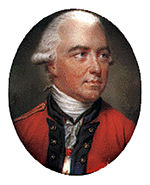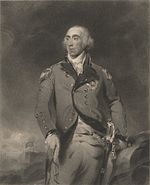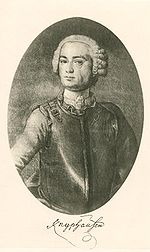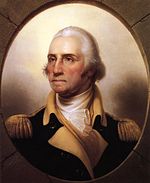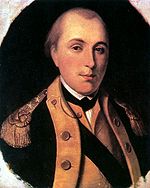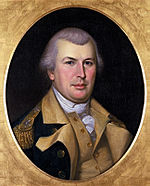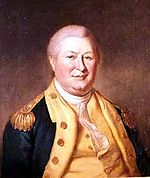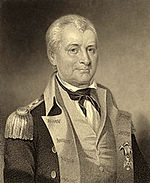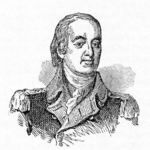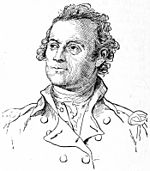- Monmouth order of battle
-
The Battle of Monmouth on June 28, 1778 saw a colonial American army under Major General George Washington fight a British army led by Lieutenant General Henry Clinton. After evacuating Philadelphia, Pennsylvania on June 18, Clinton intended to march his 13,000-man army to New York City. Washington sent 6,400 troops commanded by Major General Charles Lee to attack the British column of march near Monmouth Court House, New Jersey. When Clinton counterattacked, Lee ordered his badly-deployed troops to fall back immediately. Washington brought up 7,000 men to support Lee's withdrawing wing and held his ground against repeated British assaults. That evening Clinton retreated from the field and continued his march to Sandy Hook where the British fleet waited to ferry his army to New York. Both armies' casualties were about even in the last major battle in the northern colonies. Lee was court martialed for his behavior during the battle.[1]
Contents
British Army order of battle
Lieutenant General Henry Clinton (12,000-13,000)[2]
Brigadier General Sir William Erskine, 1st Baronet, Quartermaster General1st Division
Lieutenant General Charles Cornwallis, 1st Marquess Cornwallis[3]
- Artillery: Two 12-pound, 12 6-pound, and two 3-pound guns
- Unbrigaded:
- 16th Light Dragoons
- Queen's Rangers
- 1st Light Infantry Battalion, Lieutenant Colonel Robert Abercromby of Airthrey[4]
- 14 light companies of the line
- Guards Brigade: Colonel Charles O'Hara[5]
- Elements of 1st Foot Guard, 2nd Foot Guard, and 3rd Foot Guard Regiments
- 1st Battalion[6]
- Grenadier company, Lieutenant Colonel Sir George Osborn[7]
- Hyde's company
- Wrottesley's company
- Cox's company
- Garth's company
- 2nd Battalion
- Stephen's company
- Murray's company
- O'Hara's company
- Martin's company
- Light company
- Grenadiers:[8]
- 1st Grenadier Battalion, Lieutenant Colonel William Medows
- 16 grenadier companies of the line
- 2nd Grenadier Battalion, Colonel Henry Monckton †
- 15 grenadier companies of the line
- 1st Grenadier Battalion, Lieutenant Colonel William Medows
- 3rd Brigade: General Charles Grey, 1st Earl Grey
- 15th Foot
- 17th Foot
- 42nd Foot
- 44th Foot
- 4th Brigade: Commander unknown[9]
- 33rd Foot
- 37th Foot
- 46th Foot
- 64th Foot
- 5th Brigade: Brigadier General Alexander Leslie
- 7th Foot
- 26th Foot
- 63rd Foot
- Hessian Brigade: Colonel Johann August von Loos[10][11]
- Linsing Grenadier Battalion
- Minningerode Grenadier Battalion
- Lengerke Grenadier Battalion
2nd Division
Lieutenant General Wilhelm von Knyphausen (not engaged)[12]
- Unbrigaded:
- 17th Light Dragoons
- 2nd Light Infantry Battalion, Major John Maitland[13]
- 14 light companies of the line
- Hessian Jäger: Lieutenant Colonel Ludwig von Wurmb
- Foot Jäger company, Captain Johann Ewald[14]
- Foot Jäger company, Captain Carl Wreden
- Mounted Jäger company, Captain Richard Lorey
- Maryland loyalists
- Pennsylvania loyalists
- West Jersey loyalists
- 1st Brigade: Major General James Grant[15]
- 4th Foot
- 28th Foot
- 49th Foot
- 2nd Brigade: Major General Grant
- 5th Foot
- 27th Foot
- 55th Foot
- Hessian Brigade: Major General Johann Daniel Stirn[16][17]
- Erbprinz Infantry Regiment
- Donop Infantry Regiment
- Mirbach Infantry Regiment
American Army order of battle
Major General George Washington (11,000)[18][19][20]
Advanced Guard
Major General Charles Lee[21]
- Artillery: Four 3-pound guns, eight 6-pound guns
- Advance Guard: Brigadier General Anthony Wayne
- Varnum's Brigade: Brigadier General James Mitchell Varnum (300-600)[22]
- Jackson's Regiment: Colonel Henry Jackson (200)
- 9th Pennsylvania Regiment (detached from 3rd Pennsylvania Brigade)
- Scott's Brigade (300-600)[note 1]
- La Fayette's Detachment: Major General Gilbert du Motier, marquis de La Fayette (1,000)
- 3rd Maryland Regiment (detached from 1st Maryland Brigade)
- 3rd New Hampshire Regiment (detached from Poor)
- 4th New York Regiment (detached from Poor)
- 4th Pennsylvania Regiment (detached from Butler)
- 13th Pennsylvania Regiment
- 5th Virginia Regiment (detached from Muhlenberg)
- Scott's Brigade: Brigadier General Charles Scott (1,440)
- 4th Virginia Regiment
- 8th Virginia Regiment
- 11th Virginia Regiment (detached from Woodford)
- 12th Virginia Regiment
- 4th Maryland Regiment (detached from 2nd Maryland Brigade)
- 14th Massachusetts Regiment (detached from Patterson)
- 1st New Hampshire Regiment (detached from Poor)
- New Jersey Brigade: Brigadier General William Maxwell (900-1,000)
- New Jersey Militia Brigade: Brigadier General Philemon Dickinson (800)
Right Wing
Major General Nathanael Greene[23]
- Artillery: Four 3-pound guns, two 6-pound guns
- 1st Virginia Brigade: Brigadier General Peter Muhlenberg (575)
- 1st Virginia Regiment
- 9th Virginia Regiment
- 13th Virginia Regiment
- Hausegger's German Battalion
- 2nd Virginia Brigade: Brigadier General George Weedon (449)
- 3rd Virginia Brigade: Brigadier General William Woodford (385)
- Maryland Brigades: Brigadier General William Smallwood
- 1st Maryland Brigade: Unknown commander (657)
- 2nd Maryland Brigade: Unknown commander (529)
- New Hampshire Brigade: Brigadier General Enoch Poor (639)
- North Carolina Brigade: Brigadier General Lachlan McIntosh (369)
- Connecticut Brigade: Brigadier General Jedediah Huntington (509)
Left Wing
Major General William Alexander, Lord Stirling[24]
- Artillery: Four 3-pound guns, two 6-pound guns
- 1st Pennsylvania Brigade: Colonel James Chambers (352)
- 1st Pennsylvania Regiment, Colonel James Chambers[25]
- 2nd Pennsylvania Regiment
- 7th Pennsylvania Regiment
- 10th Pennsylvania Regiment
- 2nd Pennsylvania Brigade: Colonel Francis Johnston (401)
- 5th Pennsylvania Regiment, Colonel Francis Johnston[26]
- 8th Pennsylvania Regiment
- 11th Pennsylvania Regiment
- 3rd Pennsylvania Brigade: Colonel Robert Magaw (343)
Note that at Valley Forge, the Pennsylvania brigades were led by Colonel Thomas Hartley, Lieutenant Colonel William Butler, and Brigadier General Thomas Conway.[27]
- 2nd Massachusetts Brigade: Brigadier General John Glover (512)
- 3rd Massachusetts Brigade: Brigadier General John Patterson (357)
- 4th Massachusetts Brigade: Brigadier General Ebenezer Learned (294)
Notes
- Footnotes
- ^ It is not clear what Johnson meant by this unit. Scott's 4th Virginia Brigade consisted of the 4th, 8th, and 12th Regiments, which were named separately.
- Citations
- ^ Eggenberger, 282
- ^ Johnson, 95. Johnson listed the British total strength and the organization down to brigade and detachment level.
- ^ Monmouth war game. This source specified the regiments in Cornwallis' division, but not those in Knyphausen's division.
- ^ McGuire (2006), 205. The author gave the 1st Light Battalion organization at the time of the Battle of Brandywine.
- ^ McGuire (2006), 33. This brigade, with a strength of 1,000 men, was drawn by lottery from the three foot guard regiments.
- ^ McGuire (2006), 379. The battalion's company organization was for September 12, 1777.
- ^ McGuire (2006), 6
- ^ McGuire (2006), 205. The author gave the grenadier organization at the time of the Battle of Brandywine.
- ^ Monmouth war game. This source lists James Agnew but he was killed at the Battle of Germantown.
- ^ McGuire (2006), 162. McGuire noted that the three grenadier battalions listed here fought at Red Bank. The war game only named three generic units.
- ^ Johnson, 95. The author placed the Hessian grenadiers in the 1st Division.
- ^ Johnson, 95. Johnson gave the general organization of Knyphausen's division.
- ^ McGuire (2006), 205. The author gave the 2nd Light Battalion organization at the time of the Battle of Brandywine.
- ^ McGuire, 289. The author listed these units at Brandywine.
- ^ Johnson, 70. Johnson listed the 1st and 2nd Brigade units in his Germantown order of battle.
- ^ Johnson, 70. Johnson placed Erbprinz and Donop in Stirn's brigade at Germantown.
- ^ McGuire (2007), 162. McGuire noted that Mirbach fought at Red Bank. It is not known which Hessian brigade the unit was assigned to.
- ^ Johnson, 94. The author listed all the American units strengths. However, two General Scott brigades are listed.
- ^ Monmouth war game. The game listed all regiments except Varnum's brigade. It listed the 1st Virginia twice. The 11th Virginia was assumed to be assigned to Scott.
- ^ n2geneology.com. This source was useful in determining the brigade numbers.
- ^ Monmouth war game. This source listed the specific units in Lee's Advanced Guard, except Varnum's Brigade which was one unit.
- ^ ushistory.org. This source gave the regiments in Varnum's brigade.
- ^ Monmouth war game. This source listed the units in Greene's wing.
- ^ Monmouth war game. This source listed the units in Stirling's wing. It gave the three Pennsylvania brigade commanders as "Chmbr", "Johnsn", and "Magaw".
- ^ McGuire (2006), 249
- ^ McGuire (2006), 248
- ^ usahistory.org, Valley Forge
References
- Eggenberger, David (1985). An Encyclopedia of Battles. New York: Dover Publications. ISBN 0-486-24913-1.
- Johnson, Curt (1975). Battles of the American Revolution. London: Rand McNally & Company. ISBN 0-528-81022-7.
- Martin, David G., Millman, Leonard, Smith, Eric Lee. Battle of Monmouth: The Colonies take the Offensive war game. New York, NY: Simulations Publications, Inc., 1982.
- McGuire, Thomas J. (2006). The Philadelphia Campaign, Volume I. Mechanicsburg, Penn.: Stackpole Books. ISBN 0-8117-0178-6.
- McGuire, Thomas J. (2007). The Philadelphia Campaign, Volume II. Mechanicsburg, Penn.: Stackpole Books. ISBN 0-8117-0206-5.
- n2geneology.com American Revolutionary War Units
- ushistory.org Regiments at Valley Forge
Categories:- American Revolutionary War orders of battle
Wikimedia Foundation. 2010.


